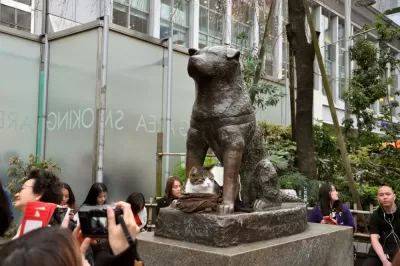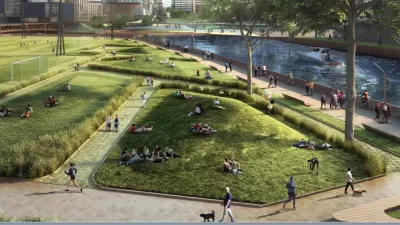When is a dog park more than just a park for dogs?

Kriston Capps reports on plans for a "luxury dog park" included in the controversial Lincoln Yards mega-development planned in Chicago.
When it’s completed over the next decade or so, the dog park nestled inside Lincoln Yards, a much-discussed $6 billion mega-development now taking shape on Chicago’s waterfront, could be the toniest pet playground in the nation. With its splash pool and pug-mug video installation—an homage to Millennium Park’s famous Crown Fountain—the only thing SOM’s design for Chicago puppers is missing is an oversized mirrored bone.
Though the dog park is one of the least controversial components of the project, according to Capps, it's still a "small marker of disparity in the city." The consequences of this marker, "range from worrisome sign of neighborhood gentrification to outright structural inequality," writes Capps.
Capps details the imbalance of dog park locations in the city of Chicago, where the fine for allowing having a dog off-leash is $300. Tickets for off-leash dogs are disproportionately written in African-American neighborhoods, and dog parks are disproportionately located in affluent, whiter neighborhoods. "Almost all of Chicago’s dog parks fall in areas that are majority white, though such neighborhoods make up a relatively small part of Chicago’s geography," explains Capps.
Still, there's reason to think the imbalance might change. Plans for five dog parks are currently in the works for the South Side of Chicago. Capps also connects the Chicago example to the larger, national conversation about the growing influence of dog owners in parks and open space planning.
FULL STORY: Are Dog Parks Exclusionary?

Alabama: Trump Terminates Settlements for Black Communities Harmed By Raw Sewage
Trump deemed the landmark civil rights agreement “illegal DEI and environmental justice policy.”

Planetizen Federal Action Tracker
A weekly monitor of how Trump’s orders and actions are impacting planners and planning in America.

Why Should We Subsidize Public Transportation?
Many public transit agencies face financial stress due to rising costs, declining fare revenue, and declining subsidies. Transit advocates must provide a strong business case for increasing public transit funding.

Understanding Road Diets
An explainer from Momentum highlights the advantages of reducing vehicle lanes in favor of more bike, transit, and pedestrian infrastructure.

New California Law Regulates Warehouse Pollution
A new law tightens building and emissions regulations for large distribution warehouses to mitigate air pollution and traffic in surrounding communities.

Phoenix Announces Opening Date for Light Rail Extension
The South Central extension will connect South Phoenix to downtown and other major hubs starting on June 7.
Urban Design for Planners 1: Software Tools
This six-course series explores essential urban design concepts using open source software and equips planners with the tools they need to participate fully in the urban design process.
Planning for Universal Design
Learn the tools for implementing Universal Design in planning regulations.
Caltrans
Smith Gee Studio
Institute for Housing and Urban Development Studies (IHS)
City of Grandview
Harvard GSD Executive Education
Toledo-Lucas County Plan Commissions
Salt Lake City
NYU Wagner Graduate School of Public Service





























